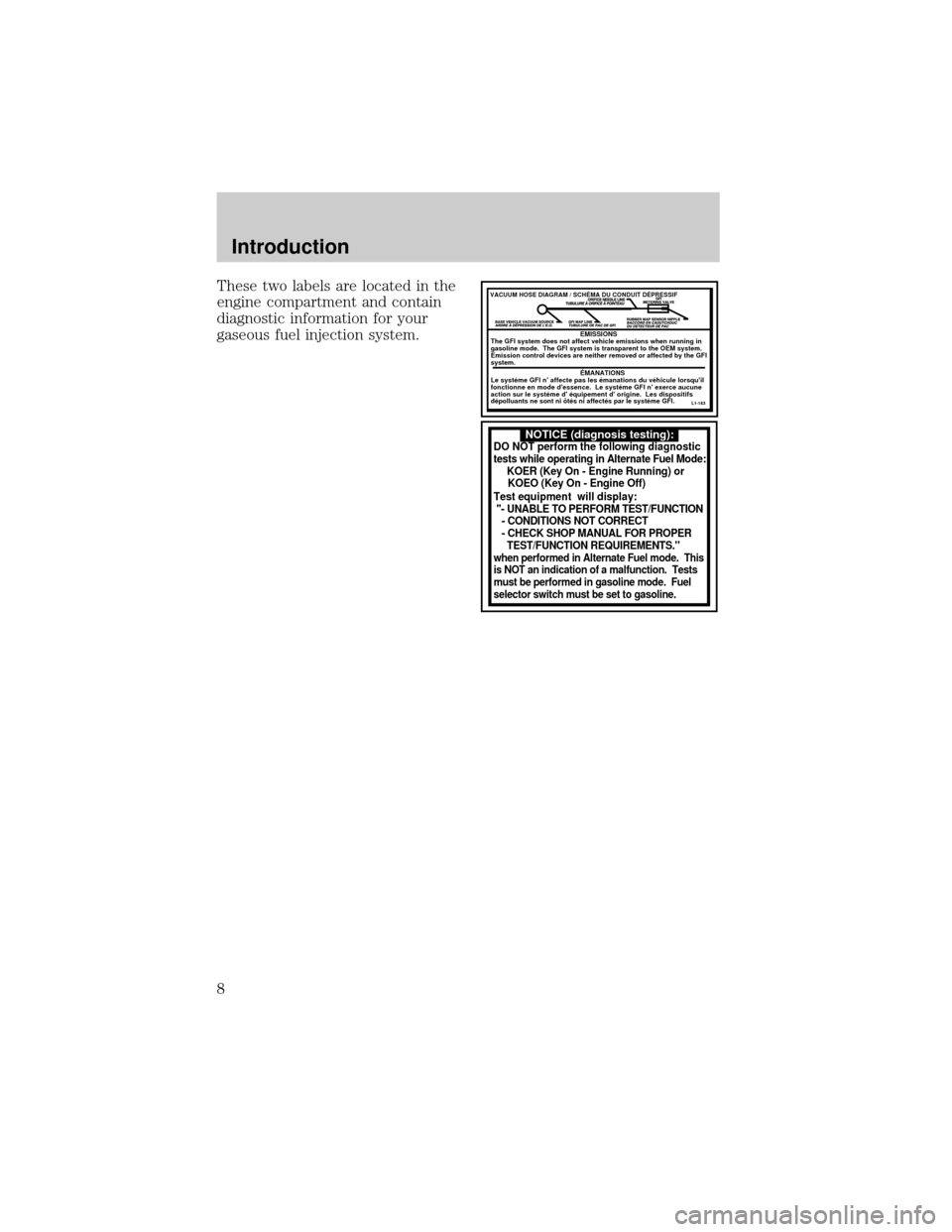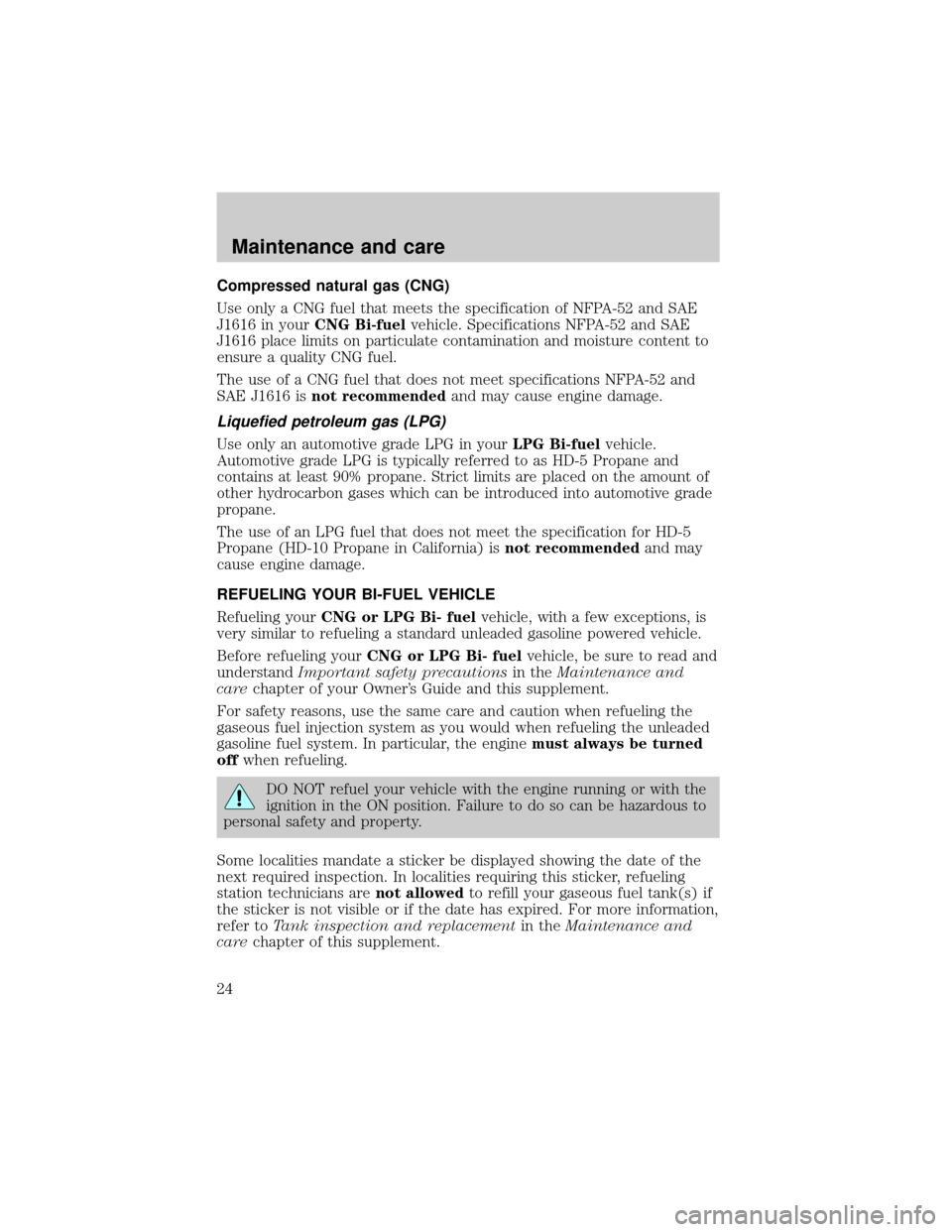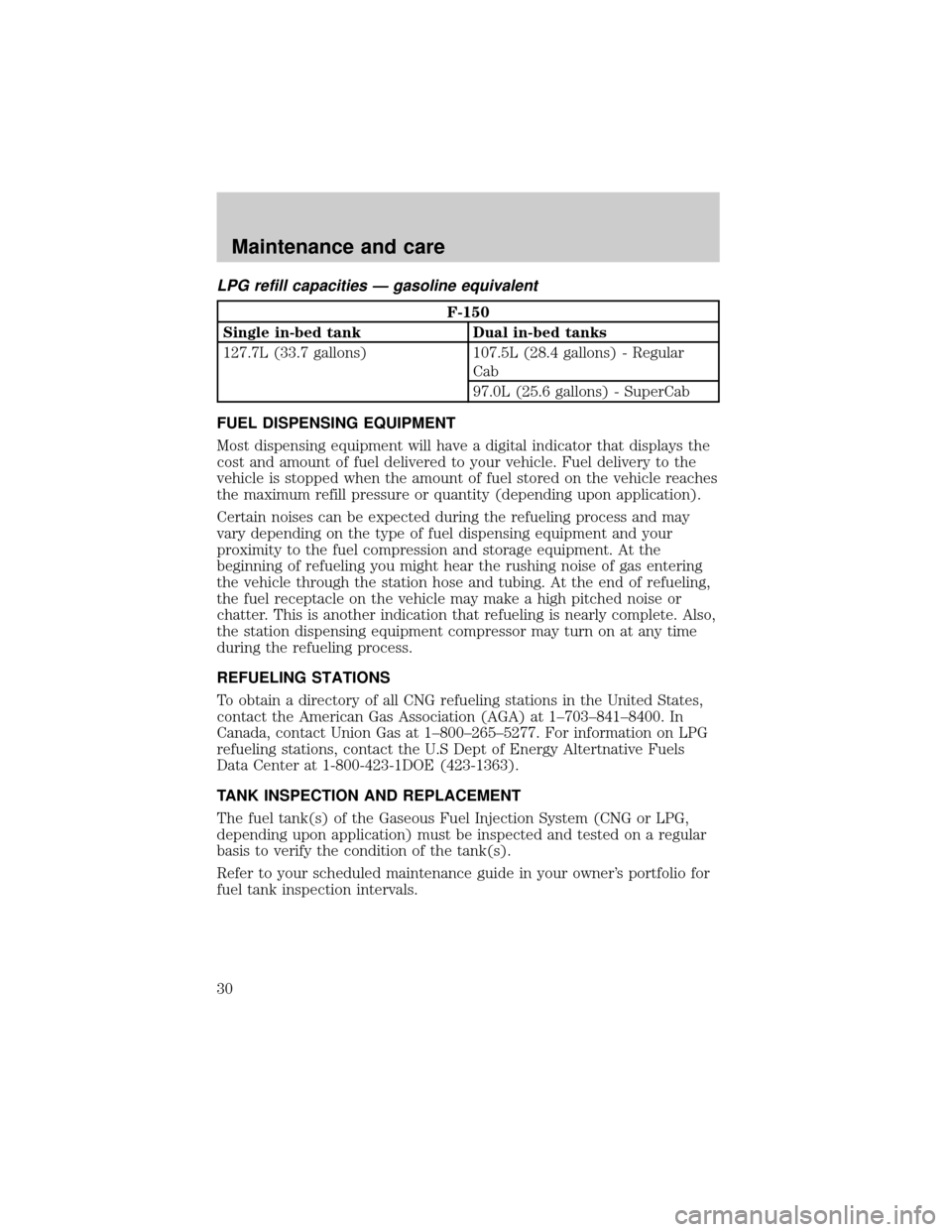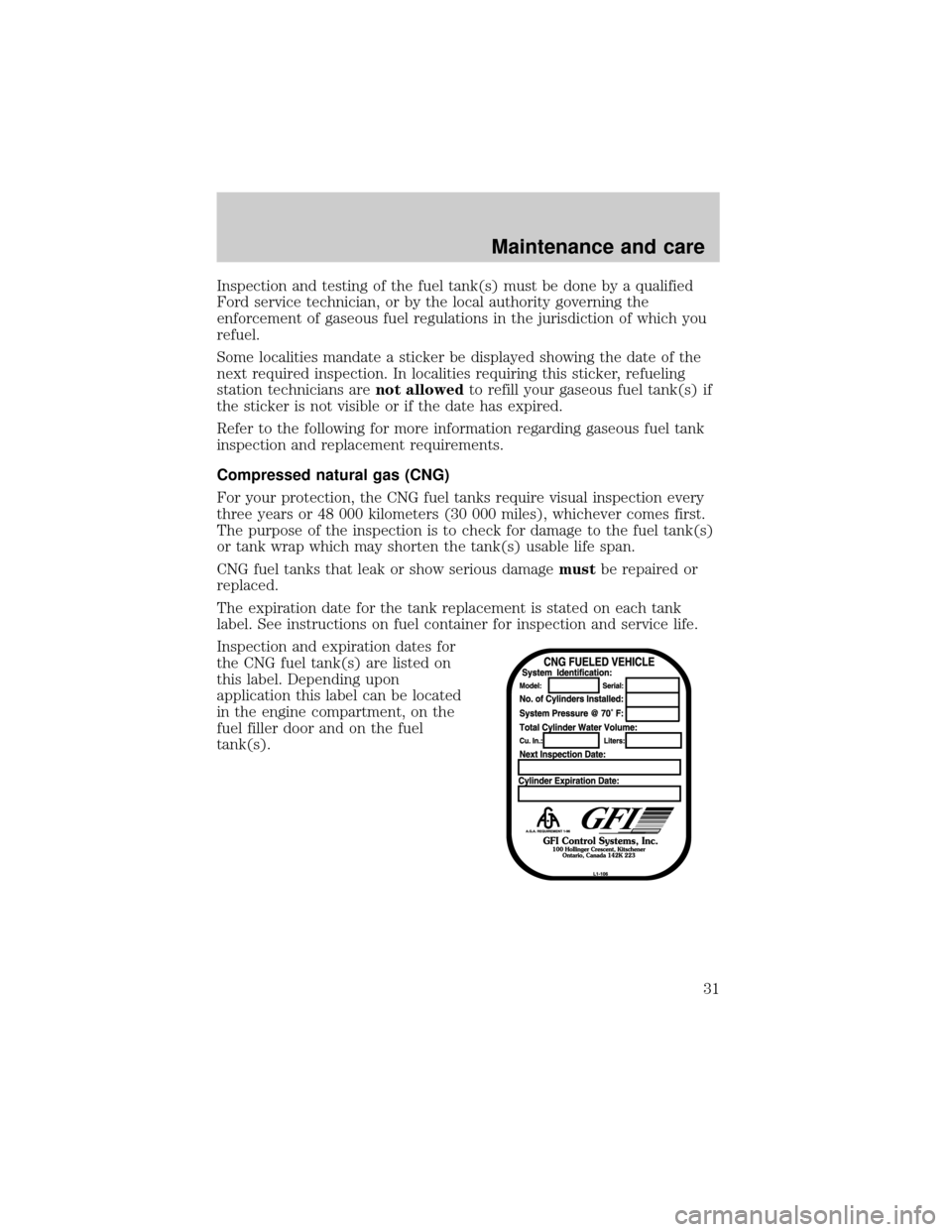Page 8 of 32

These two labels are located in the
engine compartment and contain
diagnostic information for your
gaseous fuel injection system.
NOTICE (diagnosis testing):DO NOT perform the following diagnostic
tests while operating in Alternate Fuel Mode:
KOER (Key On - Engine Running) or
KOEO (Key On - Engine Off)
Test equipment will display:
"- UNABLE TO PERFORM TEST/FUNCTION
- CONDITIONS NOT CORRECT
- CHECK SHOP MANUAL FOR PROPER
TEST/FUNCTION REQUIREMENTS."
when performed in Alternate Fuel mode. This
is NOT an indication of a malfunction. Tests
must be performed in gasoline mode. Fuel
selector switch must be set to gasoline.
VACUUM HOSE DIAGRAM / SCHÉMA DU CONDUIT DÉPRESSIF
EMISSIONS
The GFI system does not affect vehicle emissions when running in
gasoline mode. The GFI system is transparent to the OEM system.
Emission control devices are neither removed or affected by the GFI
system.
ÉMANATIONS
Le systéme GFI n' affecte pas les émanations du véhicule lorsqu'il
fonctionne en mode d'essence. Le systéme GFI n' exerce aucune
action sur le systéme d' équipement d' origine. Les dispositifs
dépolluants ne sont ni ôtés ni affectés par le systéme GFI.
L1-183
Introduction
8
Page 24 of 32

Compressed natural gas (CNG)
Use only a CNG fuel that meets the specification of NFPA-52 and SAE
J1616 in yourCNG Bi-fuelvehicle. Specifications NFPA-52 and SAE
J1616 place limits on particulate contamination and moisture content to
ensure a quality CNG fuel.
The use of a CNG fuel that does not meet specifications NFPA-52 and
SAE J1616 isnot recommendedand may cause engine damage.
Liquefied petroleum gas (LPG)
Use only an automotive grade LPG in yourLPG Bi-fuelvehicle.
Automotive grade LPG is typically referred to as HD-5 Propane and
contains at least 90% propane. Strict limits are placed on the amount of
other hydrocarbon gases which can be introduced into automotive grade
propane.
The use of an LPG fuel that does not meet the specification for HD-5
Propane (HD-10 Propane in California) isnot recommendedand may
cause engine damage.
REFUELING YOUR BI-FUEL VEHICLE
Refueling yourCNG or LPG Bi- fuelvehicle, with a few exceptions, is
very similar to refueling a standard unleaded gasoline powered vehicle.
Before refueling yourCNG or LPG Bi- fuelvehicle, be sure to read and
understandImportant safety precautionsin theMaintenance and
carechapter of your Owner's Guide and this supplement.
For safety reasons, use the same care and caution when refueling the
gaseous fuel injection system as you would when refueling the unleaded
gasoline fuel system. In particular, the enginemust always be turned
offwhen refueling.
DO NOT refuel your vehicle with the engine running or with the
ignition in the ON position. Failure to do so can be hazardous to
personal safety and property.
Some localities mandate a sticker be displayed showing the date of the
next required inspection. In localities requiring this sticker, refueling
station technicians arenot allowedto refill your gaseous fuel tank(s) if
the sticker is not visible or if the date has expired. For more information,
refer toTank inspection and replacementin theMaintenance and
carechapter of this supplement.
Maintenance and care
24
Page 30 of 32

LPG refill capacities Ð gasoline equivalent
F-150
Single in-bed tank Dual in-bed tanks
127.7L (33.7 gallons) 107.5L (28.4 gallons) - Regular
Cab
97.0L (25.6 gallons) - SuperCab
FUEL DISPENSING EQUIPMENT
Most dispensing equipment will have a digital indicator that displays the
cost and amount of fuel delivered to your vehicle. Fuel delivery to the
vehicle is stopped when the amount of fuel stored on the vehicle reaches
the maximum refill pressure or quantity (depending upon application).
Certain noises can be expected during the refueling process and may
vary depending on the type of fuel dispensing equipment and your
proximity to the fuel compression and storage equipment. At the
beginning of refueling you might hear the rushing noise of gas entering
the vehicle through the station hose and tubing. At the end of refueling,
the fuel receptacle on the vehicle may make a high pitched noise or
chatter. This is another indication that refueling is nearly complete. Also,
the station dispensing equipment compressor may turn on at any time
during the refueling process.
REFUELING STATIONS
To obtain a directory of all CNG refueling stations in the United States,
contact the American Gas Association (AGA) at 1±703±841±8400. In
Canada, contact Union Gas at 1±800±265±5277. For information on LPG
refueling stations, contact the U.S Dept of Energy Altertnative Fuels
Data Center at 1-800-423-1DOE (423-1363).
TANK INSPECTION AND REPLACEMENT
The fuel tank(s) of the Gaseous Fuel Injection System (CNG or LPG,
depending upon application) must be inspected and tested on a regular
basis to verify the condition of the tank(s).
Refer to your scheduled maintenance guide in your owner's portfolio for
fuel tank inspection intervals.
Maintenance and care
30
Page 31 of 32

Inspection and testing of the fuel tank(s) must be done by a qualified
Ford service technician, or by the local authority governing the
enforcement of gaseous fuel regulations in the jurisdiction of which you
refuel.
Some localities mandate a sticker be displayed showing the date of the
next required inspection. In localities requiring this sticker, refueling
station technicians arenot allowedto refill your gaseous fuel tank(s) if
the sticker is not visible or if the date has expired.
Refer to the following for more information regarding gaseous fuel tank
inspection and replacement requirements.
Compressed natural gas (CNG)
For your protection, the CNG fuel tanks require visual inspection every
three years or 48 000 kilometers (30 000 miles), whichever comes first.
The purpose of the inspection is to check for damage to the fuel tank(s)
or tank wrap which may shorten the tank(s) usable life span.
CNG fuel tanks that leak or show serious damagemustbe repaired or
replaced.
The expiration date for the tank replacement is stated on each tank
label. See instructions on fuel container for inspection and service life.
Inspection and expiration dates for
the CNG fuel tank(s) are listed on
this label. Depending upon
application this label can be located
in the engine compartment, on the
fuel filler door and on the fuel
tank(s).
Maintenance and care
31